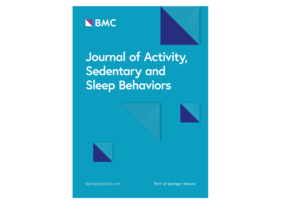
We are celebrating the first articles being published in the Journal of Activity, Sedentary and Sleep Behaviors (JASSB)! Why are you excited to be Editor-in-Chief of this new journal?
First of all, it is an honour for any researcher to be invited as Editor-in-Chief for a scientific journal. However, more importantly, I am excited by the opportunities the new journal brings to advance the science that examines physical activity, sedentary behavior and sleep using a 24-hour paradigm. If we really want to understand the correlations and health impact of these behaviors, and design effective interventions aiming to improve these behaviors, then they should be studied together – as they compete for time with one another.
The new journal will provide a strong and dedicated platform for this important area of research, and I’m convinced it will help to make a difference. I’m also excited because starting a new journal is a challenge; it’s much harder than taking over the reins of an established and successful journal, but I always like a good challenge. Because of how the academic world operates, there are incentives to publish in established journals rather than new journals. I’m convinced these barriers will be overcome, though it may take some time. That JASSB is being published by a reputable Publisher such as BMC (part of Springer Nature) means the journal is in good hands and provides a strong guarantee for submitting authors that the journal will go from strength to strength.
What is your vision for the journal for the next 5 years?
 My vision for JASSB for the next 5 years is to make it the leading journal worldwide for research concerned with 24-hour movement behaviors. This means that the journal is the first choice for authors aiming to publish work in this space, and that they are submitting their best work to the journal. This also means the journal will be indexed by all major databases (e.g., Scopus, Web of Sciences) and have a respectable impact factor (which I expect to keep increasing beyond the 5-year mark). Finally, it would mean that volume and quality of submissions have increased so much that I will need to appoint several Associate Editors to support me in leading the journal.
My vision for JASSB for the next 5 years is to make it the leading journal worldwide for research concerned with 24-hour movement behaviors. This means that the journal is the first choice for authors aiming to publish work in this space, and that they are submitting their best work to the journal. This also means the journal will be indexed by all major databases (e.g., Scopus, Web of Sciences) and have a respectable impact factor (which I expect to keep increasing beyond the 5-year mark). Finally, it would mean that volume and quality of submissions have increased so much that I will need to appoint several Associate Editors to support me in leading the journal.
Let’s talk about the first articles that are published in the Journal of Activity, Sedentary and Sleep Behaviors: what are the key messages? How will the studies impact the field?
Nicholas Kuzik and colleagues investigated how adherence to 24-hour movement guidelines is associated with physical, cognitive and social development indicators in 3-to-5-year olds and found that meeting both sleep and physical activity recommendations was positively associated with physical and overall development. Richard Tyler and his colleagues investigated associations between 24-hour activity compositions and motor competence in children and adolescents and found that reallocations of low-intensity physical activity or sleep to moderate-to-vigorous physical activity were associated with the largest increases in motor competence. I think the findings from these studies nicely illustrate that physical activity, sedentary behavior and sleep are indeed related to one another and that we still have a lot to learn about exactly how they are related to each other. Hence, the outcomes of these studies provide a good justification for why we need the new journal.
What are your experiences as Editor-in-Chief of a new journal – any surprises?
I have been pleasantly surprised by the submissions we have been receiving as soon as the journal was announced, often from research groups with strong reputations and often high-quality work. The establishment of the Editorial Board and their willingness to review manuscripts has also been heartening. So many were keen to be involved and it allowed me to attract high-calibre researchers from right around the world, with a good gender mix and including established and mid-to-early career researchers. One often hears the horror stories of needing to invite 20 or more potential reviewers and it still not being enough to get a minimum of two reviews. That hasn’t been my experience, on one occasion I invited four researchers and got four reviews back. How good is that? It demonstrates the field is invested in this journal and all this makes me confident the journal will be a success.
Comments